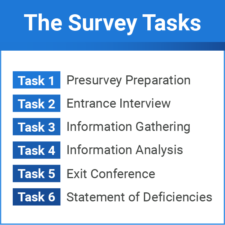Surviving Your Next Survey: The 6 Survey Tasks

Stressed out about an upcoming survey? It’s understandable, and you’re not alone.
How should a healthcare organization or agency react to survive the survey process given the significant consequences for any missteps? With recent changes, increased scrutiny, and implementation of penalties and sanctions for repeat deficiencies, it is not just about surviving surveys but all the audits that occur in the healthcare industry.
Responding to a survey is one of the most difficult and intimidating experiences an organization faces. It is imperative for organizations and the people working within them to learn what is required and how to apply your knowledge for success.
When you remove the mystery of going through a survey, you decrease fear and increase your ability to optimally perform. Just as one cannot wait until the last minute to cram for a final semester exam and expect to do well, so it is with a survey. Avoiding the disconnects between our daily operations and what is required in a survey is the best way to always be prepared.
The Six Survey Tasks
 Task 1—The surveyors gather information before their arrival.
Task 1—The surveyors gather information before their arrival.
Items reviewed may include previous surveys, any complaints or other investigations, CASPER reports, Home Health comparisons, and what comprises the organization.
Ensure your organizational chart and other information matches what has been reported to the government. If not, part of the survey will include clarifying this information, adding additional unnecessary time. The more the organization can demonstrate accurate knowledge and systems for compliance, the more it will facilitate the survey.
Task 2—The surveyor provides information about the survey and requests needed information.
This is where the tone of the survey is set. The organization must designate a liaison between the surveyor and the facility. It is also a time for staff to demonstrate their preparedness for the survey by readily providing information.
Task 3—Information is gathered from observation, documentation, and interviews with staff and patients.
This is the most time-consuming part of the survey.
Task 4—Information is analyzed and matched to the regulations.
This is when the surveyors determine whether or not the organization is in compliance.
Task 5—The exit conference
During the exit conference, the surveyors share their findings with the staff. This is also a time when clarification questions can be asked.
Task 6—The surveyor writes the deficiency report.
The organization should receive the deficiency report within 10 business days. If deficiencies have been cited, the organization must respond within 10 calendar days.
The regulations required by the state, the federal government, and the accreditation bodies are there to protect patients and ensure optimal outcomes for care. It is important to obtain accurate knowledge of the survey and create systems to meet these requirements. In this way, an organization can avoid deficiencies and untoward results.
For more practical information on avoiding common mistakes and creating robust compliant systems for success, watch the two-part MedBridge course series, “Survey Survivor.” While going through the process of survey can feel stressful, the systems you create to stay in compliance help you and your organization deliver the quality care that patients so richly deserve.
- Allen, Nancy, E. (2018). Survivor! Ten Practical Steps to Survey Survival. Solutions for Care, Inc.
- Center for Clinical Standards and Quality/Quality, Safety & Oversight Group. (2018). HHA Interpretive Guidelines. Baltimore: Centers for Medicare & Medicaid Services.
- Centers for Medicare & Medicaid Services. (2018). State Operations Manual: Appendix B—Guidance to Surveyors: Home Health Agencies. Baltimore.

